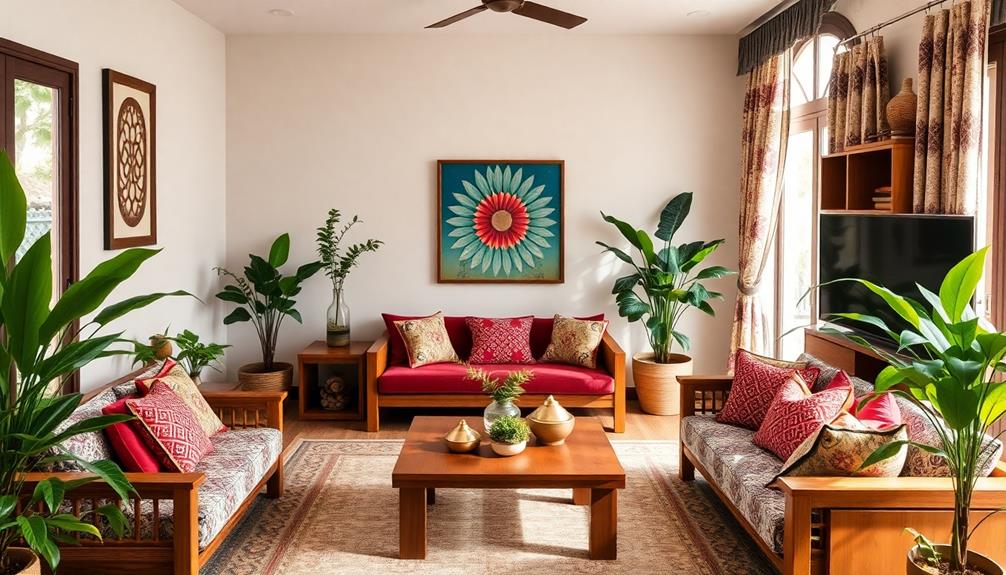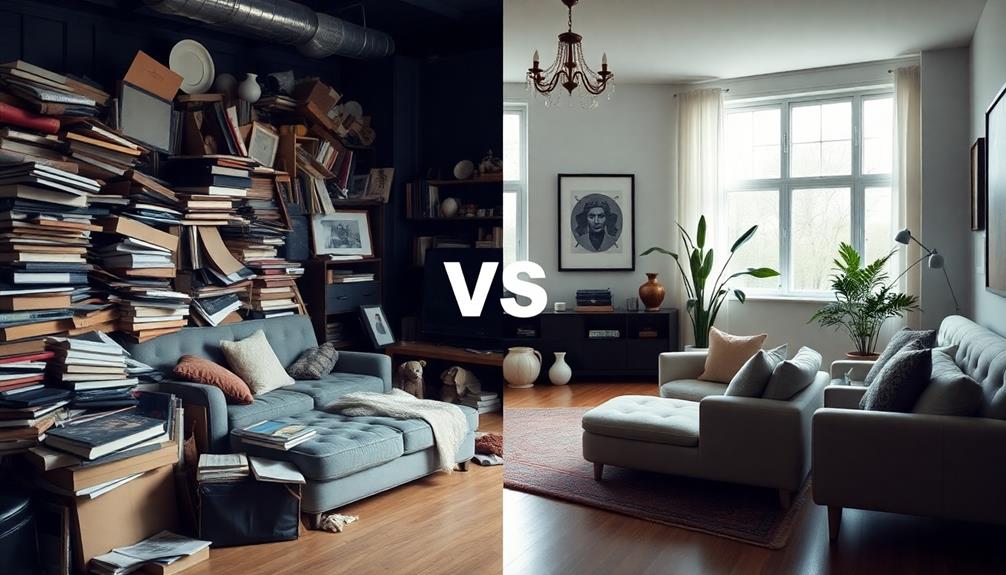Batik's intricate patterns offer a rich blend of cultural significance and artistry, making it a perfect choice for your interior design. Each design tells a story, symbolizing concepts like strength, harmony, and growth. You can use batik in your space as accent pieces or mix it with solid colors to create striking contrasts. This vibrant textile connects you to traditions and enhances your decor with meaning. By incorporating batik, you're not just decorating; you're celebrating a profound heritage. If you're curious about specific patterns and tips for integration, there's plenty more to discover.
Key Takeaways
- Batik's intricate designs reflect cultural narratives, enhancing interior spaces with meaningful storytelling and symbolism.
- Incorporate batik patterns as accent pieces to create focal points and vibrant atmospheres in your decor.
- Select motifs like Parang or Kawung to symbolize strength and harmony, infusing spaces with spiritual significance.
- Pair batik textiles with solid colors for a balanced look, allowing the patterns to stand out without overwhelming the decor.
- Embrace modern adaptations of batik to blend traditional artistry with contemporary styles, ensuring relevance in today's interior design.
What Is Batik?
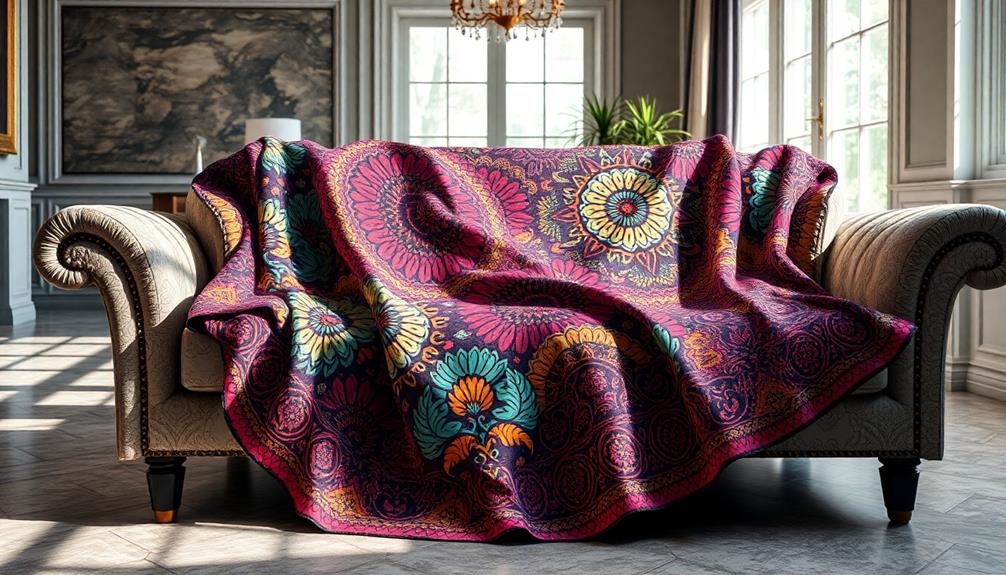
Batik embodies a rich tradition of artistry and cultural expression that dates back centuries. This ancient Indonesian textile art form uses a wax-resist dyeing technique to create intricate patterns on fabric. The term "batik" comes from the Javanese word "bathikan," which means to draw or mark, emphasizing the detailed designs that define this beautiful craft.
In addition to its textile applications, batik also inspires various decorative pieces, including traditional artistry in masks that enhance aesthetic appeal.
In Batik, traditional methods like Batik Tulis involve hand-drawing patterns, making it a labor-intensive process, while Batik Cap uses copper stamps for quicker production. Each batik design carries significant cultural meanings, often representing themes like social status, nature, and virtues deeply rooted in Indonesian culture.
The beauty of Batik lies not just in its visual appeal but also in its rich cultural significance. As you explore batik designs, you'll discover how they reflect Indonesia's diverse heritage. The intricate patterns found in Javanese batik showcase the skill of artisans and the stories they tell.
Recognized as an Intangible Cultural Heritage by UNESCO since 2009, Batik continues to thrive, inviting you to appreciate its artistry and the cultural narratives it embodies.
Historical Significance of Batik
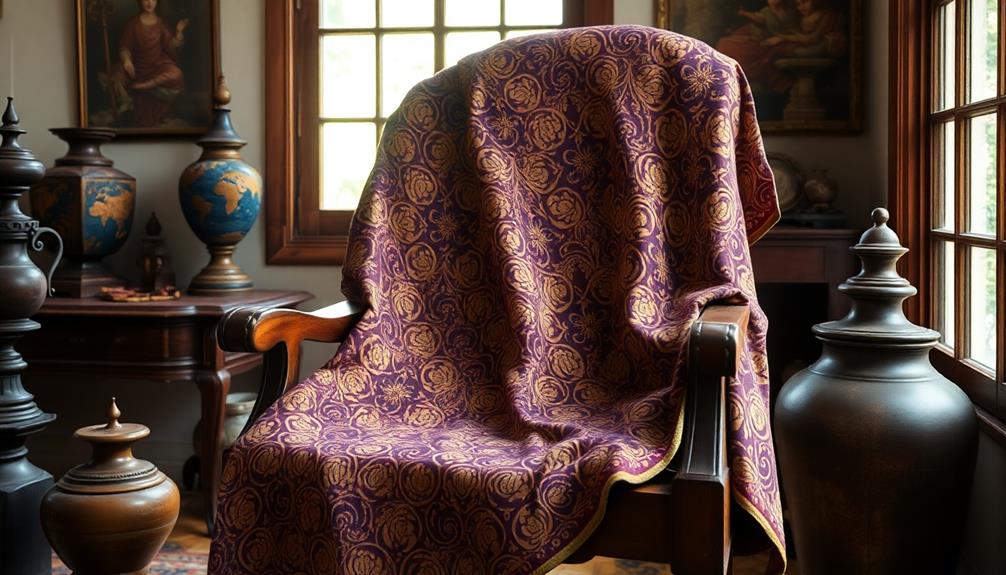
Batik isn't just a decorative art; it's an essential part of Indonesia's cultural heritage. The intricate patterns and vibrant colors often tell stories of the region's history and spiritual beliefs, making it a significant expression of identity.
You'll find that its intricate designs often play a key role in ceremonies and rituals, reflecting deep-rooted traditions. Understanding these ceremonial uses enhances your appreciation of batik's significance in both history and modern interior design, as it beautifully complements other elements like the unique artistic expressions found in Indonesian decor masks.
Cultural Heritage Significance
Originating in Indonesia over 2,000 years ago, the art of batik is deeply woven into the cultural fabric of the region, particularly on the island of Java.
This traditional batik method is more than just an Indonesian art form; it represents rich cultural heritage and showcases exceptional craftsmanship. Each piece reflects unique batik designs that tell stories, with patterns often inspired by nature, mythology, and social status.
Additionally, much like Indonesian decor masks, batik embodies intricate artistry that enhances aesthetic appeal and serves as a conversation starter.
When you incorporate batik into your interior design, you're not just adding decor; you're celebrating meaningful motifs that resonate with deep cultural significance.
These motifs convey messages of protection, fertility, and harmony, connecting the viewer to centuries of tradition.
Ceremonial Uses and Practices
Ceremonial occasions in Indonesia often showcase the vibrant and intricate designs of batik, reflecting its deep-rooted significance in cultural practices. Batik plays an important part in traditional ceremonies, with distinct batik motifs symbolizing social status, protection, and fertility. For example, certain designs, like the Parang pattern, are reserved for nobility and royalty.
The use of natural materials and earth tones in batik aligns with the Balinese design characteristics, enhancing the overall aesthetic and cultural significance of the decor.
Historically, Indonesian batik textiles have been integral to rituals, representing spiritual beliefs and community values. Many believe these fabrics possess energies that can ward off evil or promote healing, enhancing their ceremonial uses.
During significant life events such as weddings and births, specific motifs and colors are carefully chosen to convey messages of hope, unity, and respect for nature and ancestors.
Recognized by UNESCO as an Intangible Cultural Heritage in 2009, batik firmly underscores its importance in ceremonial contexts within Indonesian culture. The rich tapestry of cultural traditions woven through batik not only celebrates individual milestones but also connects communities, reinforcing the shared narratives of heritage and identity.
Batik Patterns and Meanings
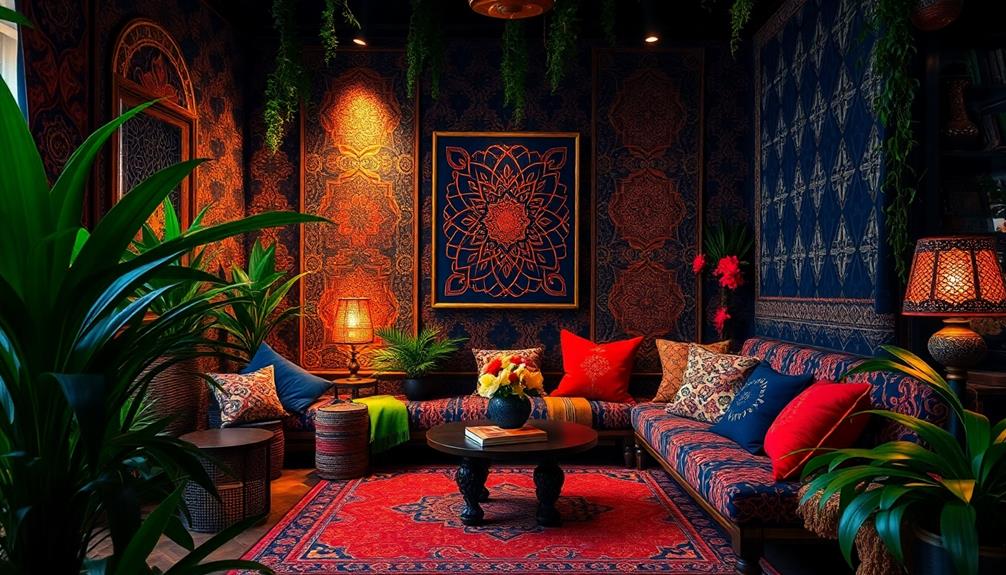
When you consider batik patterns for your interior design, you're not just choosing a style; you're embracing cultural significance and rich symbolism. Each design carries meanings that can transform your space, reflecting themes like balance, prosperity, and strength.
Incorporating handcrafted textiles, like those found in Indonesian Decorative Pillows, adds comfort and a personal touch to your decor. By understanding these patterns, you can create an environment that resonates with deeper meanings and enhances your home's atmosphere.
Cultural Significance of Patterns
Batik patterns are rich with cultural significance, each telling a unique story through its motifs. As you explore these traditional Indonesian designs, you'll discover that the meaning behind each pattern reflects the cultural richness and history of Indonesia.
These designs are often inspired by traditional Indonesian houses, which also embody deep cultural narratives and local customs, as seen in traditional Indonesian houses.
Here are three notable examples:
- Parang Pattern: Characterized by its diagonal lines, this geometric pattern signifies strength and social status, often reserved for nobility and royalty in Javanese culture.
- Kawung Motif: This pattern represents harmony and balance, showcasing the interconnectedness of life and nature. It's a reminder of the importance of equilibrium in everyday life.
- Nitik Patterns: Featuring tiny dots, these patterns symbolize fertility and growth. They're commonly used in garments for young women during coming-of-age ceremonies, highlighting their significance in cultural rites.
These unique patterns not only beautify your space but also serve as a narrative, connecting you to the historical and social values of Indonesian culture.
Incorporating batik patterns into your interior design allows you to celebrate this rich heritage while enhancing your living environment.
Symbolic Meanings in Design
Incorporating batik patterns into your interior design can transform a room by infusing it with deep symbolic meanings. Each batik design carries a rich history and culture, making it more than just a beautiful and intricate decoration.
For instance, the Kawung pattern symbolizes eternal forms and universal cycles, promoting balance and harmony in your space, which aligns perfectly with the vibrant color palettes reflecting Indonesian culture, such as red, gold, and green. If you're looking to enhance growth and abundance, consider the Mega Mendung pattern, which evokes themes of drifting clouds, fertility, and prosperity.
Indonesian wedding decor ideas often showcase these symbolic elements beautifully.
On the other hand, Parang motifs, characterized by their diagonal lines, embody strength and power, adding resilience and stability to your interior.
For nurturing creativity and life, the Nitik pattern, featuring tiny dots, represents fertility and growth, making it ideal for creative spaces.
Integrating Batik in Interior Design
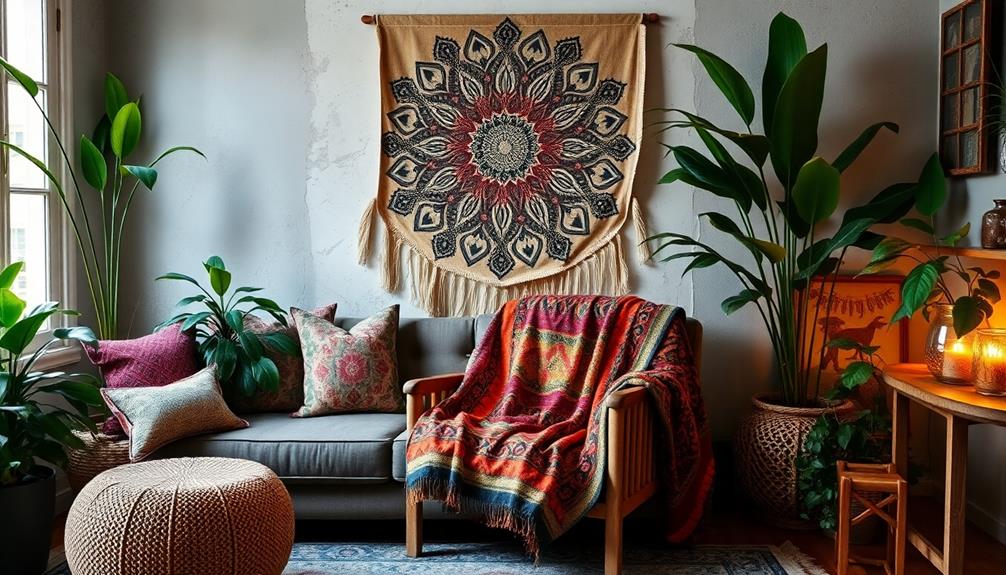
There's something enchanting about integrating batik into your interior design. The vibrant patterns and cultural richness of batik fabrics can elevate your space, particularly in modern bohemian interiors.
By combining batik with elements of traditional Indonesian style home decor, you can create a harmonious atmosphere that reflects local culture.
Here are three ways to incorporate batik design effectively:
- Use as an Accent Piece: Consider wall-mounted panels or framed textiles that highlight the intricate dyeing technique of batik. This creates a stunning focal point while keeping your decor balanced.
- Mix with Solid Colors: Pair batik patterns with solid colors to allow the detailed designs to shine without overwhelming the room. This strategy maintains harmony in your interior decor and enhances the visual appeal.
- Incorporate Antique-Inspired Textiles: Antique batik fabrics can serve as unique focal points, blending beautifully with both traditional and contemporary design styles. Their historical significance adds depth to your space.
Practical Tips for Using Batik
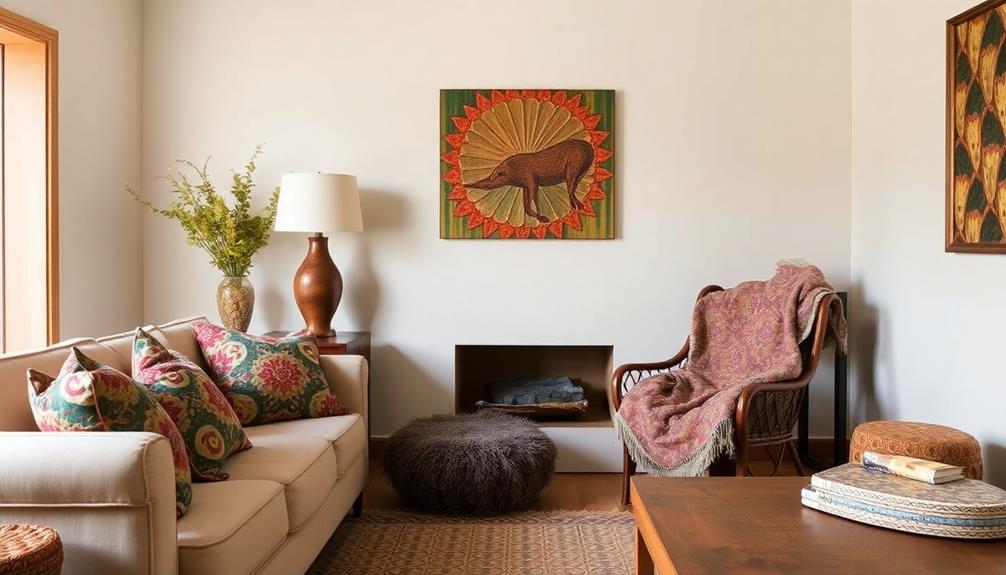
When thinking about how to enhance your space with batik, practical tips can make all the difference. Start by choosing batik patterns that complement your existing decor. Vibrant colors work beautifully as accent pieces, while soft patterns can serve as a harmonious backdrop.
To create a cohesive look, consider integrating batik textiles with elements of tropical villa plans, focusing on open spaces and natural light. It's crucial to incorporate batik textiles in small doses, like throws, cushions, or wall-mounted panels, to avoid overwhelming your room and maintain a balanced aesthetic.
Mix batik with solid colors to elevate the visual appeal. This approach draws attention to the intricate designs without clashing with other elements in your space. You might also consider using batik-inspired textiles from luxury brands, which offer contemporary interpretations that fuse tradition with modern design, ensuring elegance in your decor.
Lastly, use batik as an artistic focal point, placing it strategically in high-visibility areas to showcase its cultural significance and beauty. By following these practical tips, you can effectively incorporate batik into your design, creating a space that not only looks stunning but also tells a story through its vibrant colors and rich history.
Modern Adaptations of Batik
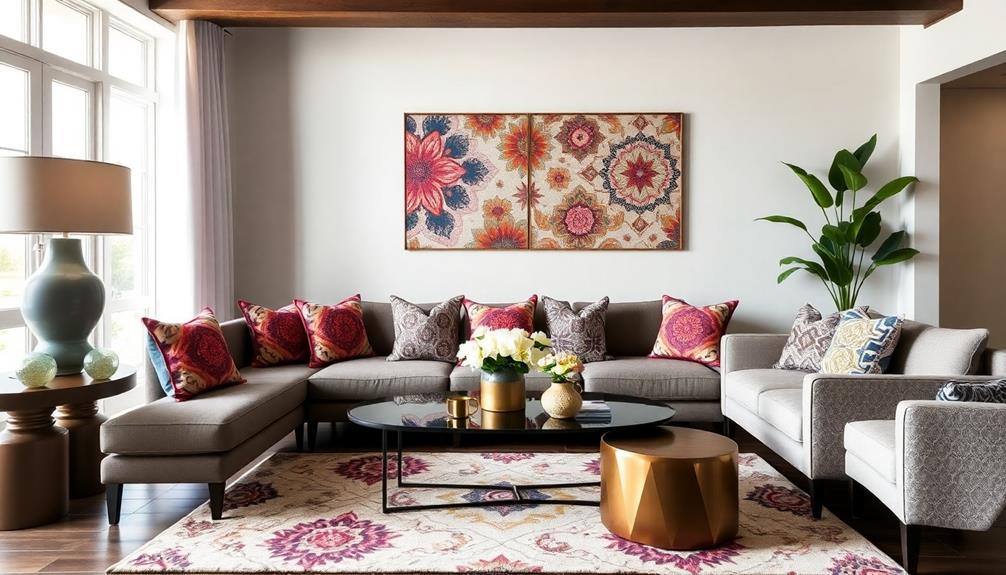
Modern adaptations of batik frequently blend traditional motifs with contemporary designs, creating a unique aesthetic that resonates with a wide audience.
The batik industry has evolved, showcasing vibrant patterns that enhance interior decor while honoring their cultural significance. This evolution is also reflective of broader trends in Indonesian housing, where sustainable urban development practices are increasingly prioritized.
You can explore this modern take on batik in various ways:
- Accent Pieces: Incorporate batik through throws, cushions, and curtains, perfect for achieving a modern bohemian vibe in your space.
- Collaborative Creations: Look for collaborations between artists and craftspeople that offer fresh interpretations of batik, integrating it into modern artistic expressions and fashion.
- Sustainable Choices: Choose batik textiles from brands that prioritize sustainable practices, aligning your decor choices with eco-friendly values.
The Future of Batik in Decor
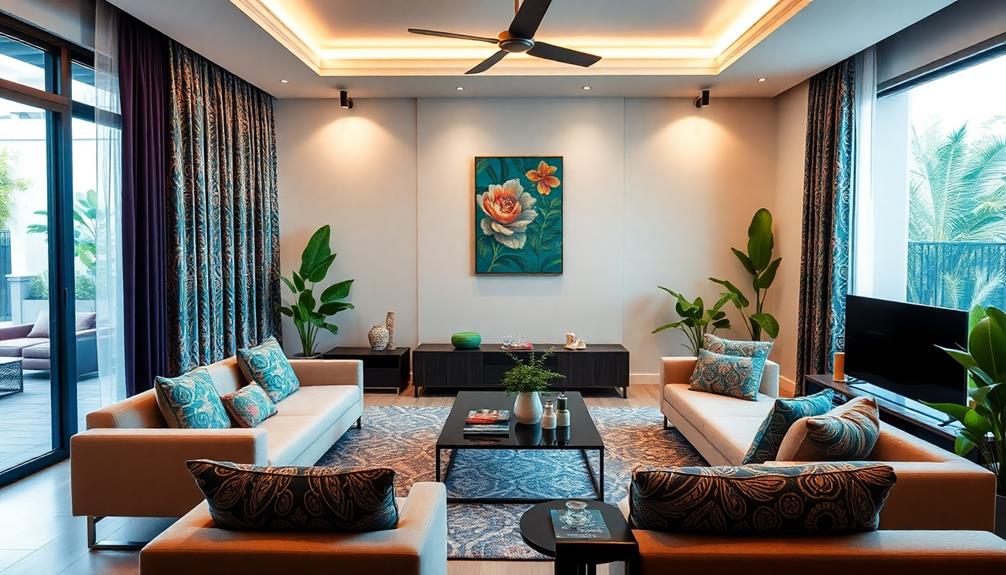
Embracing the future of batik in decor means recognizing its potential to evolve while preserving its rich cultural heritage. As you explore interior decor, you'll notice a growing trend of integrating traditional motifs into modern design. This approach not only appeals to a diverse audience but also honors the cultural significance of batik.
Sustainable practices are becoming essential, with artisans increasingly using eco-friendly materials and dyes. This shift caters to environmentally conscious consumers who want to make responsible choices in their decor.
Collaborations between batik artists and modern interior designers are resulting in innovative interpretations of batik patterns, leading to unique decor pieces that celebrate both artistry and tradition.
Digital platforms and social media play a vital role in promoting batik-inspired decor. They provide artisans and brands with a global reach, allowing you to discover stunning batik textiles that enhance your space.
These textiles have versatile applications, from statement wall art to accent cushions, ensuring their relevance in contemporary design trends. By embracing batik in your home, you not only elevate your aesthetic but also support a vibrant cultural legacy that continues to thrive in modern decor.
Frequently Asked Questions
What Does the Batik Symbolize?
Batik symbolizes cultural identity and heritage, showcasing social status and virtues. Each pattern, like Parang or Mega Mendung, tells unique stories that connect you to history, nature, and the diverse richness of Indonesian traditions.
Why Is Batik so Special?
Imagine wrapping yourself in a vibrant story. Batik's intricate patterns reflect cultural heritage, offering depth and meaning. Its unique craftsmanship and eco-friendly dyes not only beautify spaces but connect you to global traditions and artistry.
What Are the 5 Major Types of Batik Design?
You'll find five major types of batik design: Batik Tulis with hand-drawn artistry, Batik Cap using stamps, Batik Lukis featuring painted fabrics, Batik Pesisir from coastal areas, and Batik Belanda blending Western and Javanese styles.
What Is the Explanation of Batik Design?
Batik design's like a beautiful story woven into fabric, using wax-resist dyeing to create intricate patterns. Each motif carries deep meanings, reflecting nature, mythology, and culture, making it a vibrant expression of heritage and art.
Conclusion
Embracing batik in your interior design can transform your space with its rich history and vibrant patterns. As the saying goes, "Home is where the heart is," and incorporating these unique textiles can truly reflect your personality and passion for culture. Whether you choose to display batik art, use it in upholstery, or create focal points with accessories, you'll find that these pieces not only beautify your home but also tell a fascinating story.
